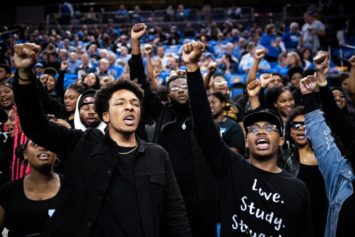
The 12-hour “speak out” in Ann Arbor was sparked by an incident in November when a fraternity promoted a race-themed party that invited “rappers, twerkers, gangsters” and others “back to da hood again.”
There has been a sharp decline in Black student enrollment at Michigan, partly because of a ban on the consideration of race in university admissions. The percentage of Black students dropped from 6.2 percent in 2009 to 4.6 percent in 2013. Ironically the enrollment drop and the sense of isolation has generated a new wave of student activism, according to the Times, including a social media campaign called “Being Black at the University of Michigan” (or, on Twitter, #BBUM). The university’s Black Student Union has petitioned campus administrators to, among other things, increase enrollment of Black students to 10 percent.
The Times story said similar episodes and tensions have hit campuses such as Arizona State, UCLA, University of Mississippi and Dartmouth.
“In the news media and in popular culture, the notion persists that millennials—born after the overt racial debates and divisions that shaped their parents’ lives—are growing up in a colorblind society in which interracial friendships and marriages are commonplace and racism is largely a relic,” the story said. “But interviews with dozens of students, professors and administrators at the University of Michigan and elsewhere indicate that the reality is far more complicated, and that racial tensions are playing out in new ways among young adults.”
“There’s this preconceived notion that our generation is postracial, but there’s these incidents that happen constantly that disprove that point,” said Zach Fields, a business major at Michigan, who is white and who attributed many high-profile incidents — including a number of fraternity parties nationwide that have used racist symbols, such as watermelons and gang signs — to ignorance.
“I feel like they don’t mean to be so offensive,” said Fields, 20. “It’s not a conscious racism. It’s subconscious.”
Tyrell Collier, 21, the speaker of the Black Student Union and a sociology and Afro-American and African studies major, told the Times that racial tensions on campus had been mounting for months.
“There was a very tense climate brewing all semester, and I think the party was just the peak,” he said, adding that Black groups on campuses around the country had reached out to the Michigan students.
“We’re clearly not postracial,” said Tiya A. Miles, chairwoman of the department of Afro-American and African studies. “Sometimes I wonder if having a Black president lets people feel like that gives them cover. It absolves people of being prejudiced.”
The statistics seem to back up the claim that there has been a rise in racist incidents: Complaints related to race and ethnicity filed against colleges and universities rose to 860 in 2013 from 555 in 2009, according to the Office for Civil Rights at the federal Education Department.
While Michigan residents in 2006 passed Proposition 2, prohibiting affirmative action based on race or ethnicity in admissions and hiring at public institutions, some students feel Michigan could still do more to recruit high-achieving Black students.
“I think there is no question that Prop 2 has made it much more challenging for us,” Martha E. Pollack, the university provost and executive vice president for academic affairs, said of the affirmative action vote. “It was difficult to be the kind of community that we wanted to be even when we could use affirmative action.”
“That sort of point is a little insulting to me,” Collier told the NPR station in Michigan, “because there are students out there who are capable of attending the University of Michigan. I think those students are just not being reached.”

